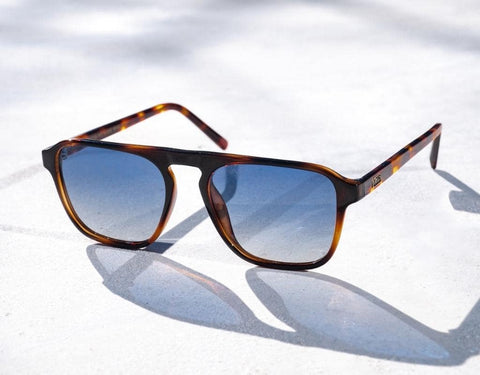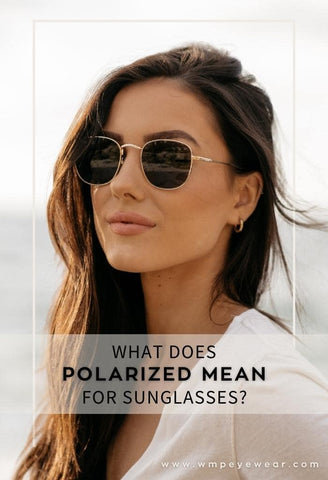What Does Polarized Mean for Sunglasses?
BY WMP PUBLISHED June 29, 2022
IN THIS ARTICLE
So you’re shopping around for a new pair of sunglasses and you’ve noticed a few words you’re not exactly familiar with.
It’s likely that you already know to look for sunglasses that have 100% UVA and UVB protection in order to guard your eyes against harmful rays, but there’s a good chance you’re lost on whether or not you want polarized or non-polarized lenses (and what the difference really is between them, anyway).
Here’s a breakdown of what polarization means when it comes to picking new shades, how it works, what it does, whether or not you’ll want to opt for a pair, and the major benefits.
Benefits of Polarized Lenses
If you find yourself squinting your eyes even when you’re wearing sunglasses, it’s time to consider buying a polarized pair. Among their practical uses for driving and glare reduction, their major benefits include the following:
- Reduced glare and visual interference
- Increased visibility
- Improved vision clarity
- Increased visual contrast
- Relief of eye strain
- Increased perception of colors
- Elimination of glare caused by reflection
- Overall improvement in visual comfort
Because of their anti-glare properties, polarized glasses are especially great for people at high-risk for cataracts. A cataract can form in the eye from excessive light exposure which could lead to needing medical care, and even surgery, without proper eye care. This makes polarized lenses perfect for driving, fishing, watersports, and other outdoor activities.
How Do Polarized Sunglass Lenses Work?
The magic of polarized sunglasses is in the lens. For those who aren’t as well-versed in the physics of light, electromagnetic waves, or how atoms respond in electrical fields, the mechanics of polarization might sound like nonsense. To summarize the science behind it in a way that won’t put you to sleep at your keyboard, we’ll keep it simple.
Any time light is projected onto a surface, it scatters in all directions. Whenever that scattered light hits a reflective surface (such as water, the road, or other cars), it’s gathered, streamlined, and reflected in a horizontal direction. This makes your eyes work harder when trying to see past these blinding streams of light.
Meanwhile, polarized lenses contain a filter which only allow light to enter vertically, blocking any horizontal light reflected from surfaces like water, other cars, or the road. In other words, polarized filters block reflected light that would otherwise hit your eyes and interfere with your vision which makes it the perfect companion for driving.
History of Polarization for Sunglasses
Polarized filters were first invented in the 1930s by American scientist, inventor, and Polaroid Corporation co-founder Edwin H. Land. If the name “Polaroid” has you thinking of vintage cameras rather than eyewear, you’re on the right track—the filters were originally considered for use with the company’s cameras.
The first polarized glasses were invented when Land applied his patented Polaroid filter to a pair of eyewear, sandwiching the film between two sheets of eyeglass. This dual-layer of glass made the first pair heavy and clunky—far from today’s sleek and stylish models.
Regardless of their lacking fashionability, the eyewear showed promise. With the construction of Route 66, the emerging tradition of the great American road trip, and the increased popularity of automobiles, polarized lenses proved useful for driving.
When World War II hit, polarized specs catapulted from trendy driving accessories to essential aviation eye protection gear. In response to fighter pilot’s need for reliable, durable, anti-glare eyewear, Ray Ban began crafting the world’s first aviator-style sunglasses, fully-equipped with polarized filters to reduce glare and improve visibility.
This allowed the pilots’ eyes to see more clearly during air strikes, navigate the skies with more precision, and fly with an increased sense of safety from better vision. They also proved trendy, and quickly caught on in pop-culture.
By the end of the war, polarized glasses had become popular among celebrities and citizens alike, spurring eyewear companies to mass produce them for public use in the 1940s.
Since then, polarization has become something of an industry standard. Most reputable eyewear brands market polarized styles, as the glasses have come to be considered a safety staple for anyone who drives.
How Polarized Sunglass Lenses Are Made
The world’s first polarized lenses were tedious to manufacture. Nowadays, modern technology has simplified the production process, making cheap polarized sunglasses a possibility.
These days, polarization happens on a mass scale in eyewear factories, where lenses are coated in a polarizer. For polycarbonate lenses, the polarizing film is carefully applied to the front of the lens at the appropriate angle and then covered in a scratch-resistant coating.
Other polarized lenses are created by melting and pouring plastic into a mold in which the polarizing film is suspended, allowing the film to melt seamlessly into the lens.
How to Tell If Sunglass Lenses Are Polarized or Not
If you’re unsure whether your current sunglasses are polarized or not, don’t sweat it— there’s a pretty easy way to tell.
Generally, polarized sunglasses are marked with a “P” or the word “Polarized” on either the lens or the eyewear’s inner arm. That said, if you’re skeptical as to whether or not your new specs are truly polarized, you don’t have to take the manufacturer's word for it—this one quick trick can help you tell for sure.
All you need is your sunglasses and a smartphone, television, or computer screen with an LCD screen. Hold the glasses out in front of you, rotating them slowly. Watch the screen through the eye lens as you move the frames— if you notice a variation in darkness and color patterns as the lens rotates, they’re polarized. If there is no change, they are likely unpolarized.
This works because sunglass lenses are polarized at an angle. Changing the angle of the glasses will impact which light from the LCD screen is permitted to pass through, creating the illusion of dark spots, patterns, or darkening of the screen.
Types of Polarized Sunglasses
These days, polarized lenses have become an industry standard, which means there’s plenty of variety and variation available for anyone looking to snag a pair.
Styles are available for any gender or style preference. Polarized sunglasses for men, for example, can be found in classic aviator styles, vintage circular frames, and just about anything in between.
Frequently Asked Questions
How much do polarized sunglasses cost?
You don’t have to break the bank in order to snag a pair of quality polarized sunglasses. With polarized lenses becoming increasingly popular, keeping your vision clear has never been easier. Modern manufacturing practices have made them incredibly affordable—generally, you can buy a pair of cheap polarized sunglasses for the same price as standard sunglasses.
Are polarized sunglasses for everyone?
For most, polarized lenses are the safest and most comfortable option. Due to COVID, digital eye strain has become more prominent than before. This means it’s extra important to protect our eyes from any additional work they might have to do on a daily basis.
That said, anyone who has mutated photoreceptor cells, meaning you receive vertical light differently, may find that polarized filters are uncomfortable or even dangerous. If wearing polarized sunglasses make you feel sick, disoriented, off-balance, or dizzy, non-polarized alternatives would be best for your eye health. Otherwise, they’re a great option for anyone who drives, plays sports, loves outdoor activities, or lives an active lifestyle.















